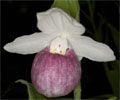|
|
|
|
|
| |
Flasks of
Cypripedium reginae ("Pacific Spirit" group) -spontaneous |
|
| |
|
|
| |
|
|
Click to Enlarge

Pod Parent Blooming Plants |
Click to Enlarge

Offspring 'Dutch Michel' Flower |
Click to Enlarge

Offspring 'Dutch Michel' Blooming Plant |
| Offspring photos are siblings of the plants you would receive. |
|
|
|
| |
Culture Notes from Donor: Parent plant: It is very hardy and forms large clumps and can be grown in a moist area in the garden with no protection required. They require a cold winter.
Comments: Parent plant: This is a very showy orchid native to the east coast of North America.
For additional origin/habitat information supplied courtesy of
Charles and Margaret Baker, see further below, near the bottom of this page.
|
Temperatures we attempt to use in the lab & greenhouse:
| For Species: |
|
Spring, Summer, Autumn: days average 80°F, nights 61°F; best fit is Intermediate 83-60°F
(Source:
Baker's Web OSC) |
| For Species: |
|
Winter: days average 25°F, nights 9°F; best fit is Frigid 46-28°F
(Source:
Baker's Web OSC) |
|
About the name...
| Etymology of |
Cypripedium |
|
From Greek "Kypris" Aphrodite; "pedilon" shoe.
(Source:
Pridgeon 1992) |
| Etymology of |
reginae |
|
From Latin "regina" queen.
(Source:
Brown 1956) |
| Pronunciation of |
Cypripedium |
|
sip-re-PEE-dee-um
(Source:
Pridgeon 1992) |
| Pronunciation of |
reginae |
|
reh-JEE-nye
(Source:
Hawkes 1978) |
|
If you would like to direct someone to this web page, please copy and paste this URL into your email:
http://troymeyers.com/d?014721
| Ordering Information |
| You are not currently logged in. |
|
You must be a registered user and be logged in to reserve a flask or place a notification request. Please log in:
|
|
|
|
|
|
| |
The origin/habitat information below is supplied courtesy of Charles and Margaret Baker
The following information is based on the name of the plant provided by the donor, and assumes that the name is correct. If the plant has been misidentified, then the following information may not be correct.
This text is copyrighted by the Bakers and may not be reproduced without permission.
ORIGIN/HABITAT: North America and possibly China and Mexico. These plants
are known to occur in Canada from Newfoundland westward to Saskatchewan
and in the northeastern U.S. to as far south as North Carolina in the east
and Missouri in the west. Plants have also been reported near Monterey in
the state of Nuevo Leon in northeastern Mexico, but we have been unable to
confirm these reports. They have also been reported as native to western
China, but details of habitat location and elevation were not given.
Plants usually grow in neutral or slightly acid soil in or on the edges of
mossy woodland swamps or bogs.
More about this information and the Bakers...
|
|
|
| |
|
|
|